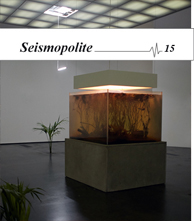August 10, 2016
Eco-Specificity: Performing the Heterogeneous Centre of The Ecological Imperative
Written by Sozita Goudouna
Sites of performance, of exhibition or display are revealed to be culturally specific situations that generate particular contexts, ethics and narratives regarding art, art history and society. Community involvement and the social division between the notions of the public and the private, is strongly associated to the ethos that is generated during the performance of site and eco-specific art projects.
The article addresses the question of the relation between “ecos” and “ethos” through an examination of the “eco-critical” and site-specific project ‘Eleventh Plateau’[1] by the non-profit company ‘Out of the box Intermedia’[2] that took place in 2011 at eleven sites in the islands of Hydra at the uninhabited island of Dokos. The following study discusses the inseparability of the work and its context and the intersection between performance and visual arts, landscape architecture and environmental science, so as to propose a theoretical framework for examining new models of site-specificity affected by the unstable relationship between ecology, location and society.
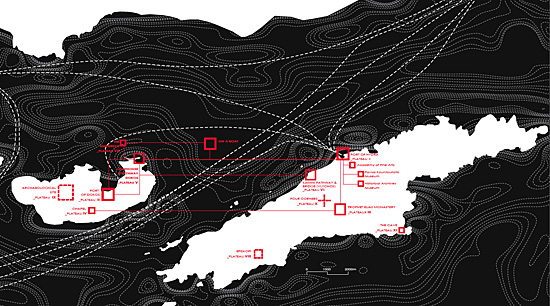
Eleven Projects/Eleven Locations:
Re:Place: ‘Compass of the Sacred,’ ‘Traces on The Rock,’ ‘Glow,’ ‘Space in Between,’ ‘Transmissions’, ‘Fragments of the Unseen’, ‘The Under’, ‘IS(o)LAND(scapes),’ ‘SoundMatter,’ ‘Aperopia,’ ‘Water-LC-Fire’.
Eleventh Plateau is a multidisciplinary project involving collaboration across universities, art companies, and scientific institutes, as a way to understand the landscape of Hydra, its origins, its influences, and the derivative effects of these on its natural and cultural milieu and as a way to promote a shift of the ecological ethos of the island in the expanded context of art practice.
The project employs structural affinities between ecology, architecture, performance, the visual arts and science so as to practically address the role of art in promoting new and critical ecological thinking and in creating innovative ecosystems by presenting performative interventions such as: the collaborative project ‘Transmissions,’ the dance piece ‘Fragments of the Unseen,’ the guided performance tours ‘IS(o)LAND(scapes),’ ‘Water-LC-Fire’ and the communal project ‘Il Cammino Comune: The Song.’ Adding to this, an exhibition with the contribution of international artists at the Hydra Museum Historical Archives (IAMY), the sitespecific project ‘Re: Place,’ involving seven architects and designed by architects: Patricia Sendin (‘Glow’), Andrea Marcucetti (‘Compass of the Sacred’), Kay Mack (‘Long Bench’), Thomas Amargianos (‘Traces on the Rock’), Tamiko Onozawa (‘Engawa’) Ebrahimi & Maximillian Vogels (‘Space In Between’), the mis-guided tour ‘A Sardine Street box of Tricks or How To Make Your Own Mis-Guided Tour On Main Street’ by Phil Smith, as well as a conference on the intersection of environmental science and landscape architecture entitled ‘Perceptual Ecologies and Territorial Assemblage’ with the participation of four universities.
Eleventh Plateau also hosted the research projects ‘Re-evaluating Space’ by the architectural group Space Syntax, ‘Modular Assemblies on Seaside Pressure Landscapes’ by the department of architecture at Patras University, the ‘Landscape of Networks: Emergent Adaptive Landscapes of Dynamic Interrelations’ by architect Achilleas Psyllidis, School of Architecture NTUA, ‘A Hydrologic Simulation & Urban Development Study’ by scientific consultant Io Karydi, ‘SoundMatter: Sound that Occupies Space’ by Room for Thought and ‘Aperopia,’ by Danae Stratou; a timelapse video created by a series of photographic stills produced during the course of a whole day from sunrise to sunset over the island of Dokos.
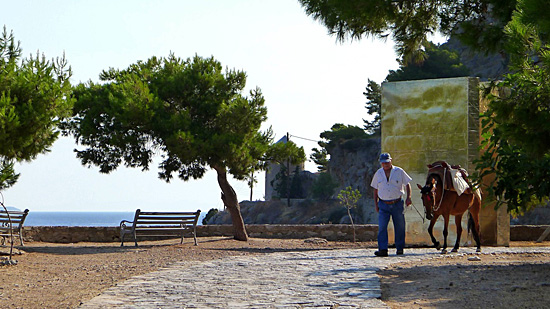
The physical condition of a specific location recedes as the primary element in the conception of a site. Conceived as an eco-specific project, “site adjusted” and “located” in relation to the environmental components of the islands of Hydra and Dokos, the project focuses on the actual land of the island. The land is seen as a living form of ecology; given that it registers the impact of governmental policy, human migration, technological developments, changing environmental values, commercial interests and the shifting boundaries of urban and rural areas. The art projects presented in the context of the project in Hydra and Dokos became absorbed by the actual sites and restructured both conceptually and perceptually the organization of these sites.
Eleventh Plateau is determined by the topography of the islands, the environmental context, architecture, history and social structure. The fundamental aim is to create a dialogue between artists, scientists and the community of the island while provoking the viewer’s acuity regarding ideological, ethical and ecological conditions of their viewing.
The contributors draw on environmental developments so as to devise temporal and spatial interrelations, new forms of art interventions and to unfold a wide range of projects that explore the relationships between spectator/scenographer, event/scene, intervention/cultural production and artist/scientist. The projects investigate the different layers of the island: the archeological past, contemporary economic culture, the ecological future, the excluded and the popular, zoology (animal/human interrelations), land art and shifts in the representation of nature by displacing the performances and the objects of art from the theatre or gallery to the landscape.
Community Involvement: Hydra’s Ecological Association
Recent years have seen no shortage of exhibitions concerned with ecology and the environment, however, these projects seem to have had little effect on public awareness and few have criticized the problematic framework that often surrounds ecological strategies that overlook the political context. Eleventh Plateau considers the intrinsic connection of nature to the wider social, political and economic forces. The social approach is based on community participation and brings together contributions to the environmental debate from ecology-related performance and visual art collaborators by investing in the political and transformative role of the arts.
Moreover, the artistic and scientific contributions focus primarily on disseminating information concerning the malfunction of local policies on waste and water management, on the protection of the architectural heritage, on policies about fishing, scuba-diving and other significant local policies that are affected by the municipality and by the municipality’s “support” to specific economic interests. The preservation of the distinct historical and architectural landscape of Hydra is formed as a result of community involvement, however, tensions occur between the community and investors/developers who want to alter this traditional landscape.
Eleventh Plateau brings together predominantly organizations and individuals both from metropolitan centres and the periphery (Hydra’s ecological association) that would not usually work together, to uncover profound aspects of the intersection between ecology and politics in a process of intercultural dialogue between the participating individuals.
The project addresses the difference between centre and periphery, the relationship between ecology, science and culture and the fact that artists can engage the public in ecological issues through creative insight and original vision. Eleventh Plateau also promotes a cultural shift of ethos and values with regard to ecology so as to stabilize what is potentially a dangerous situation (climate change, global warming, ecologic destruction). By engaging with the immediate ecological and social reality of the island, the project has an immediate local relevance; at the same time, by discussing questions of the environmental turn, it provides responses and examples of artistic and scientific practices of wider relevance.
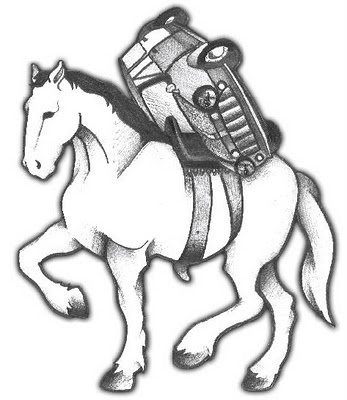
The project instigates a dialogue between the artists, the researchers and the local community by inviting members of the Ecological Association of Hydra to collaborate with the group and by interacting with the citizens of the island. The ecological association has been responsible for twenty-three years for preserving Hydra as one of the few places in the world without vehicles, by supporting the mule and the donkey culture of the island and by safeguarding the protection of Hydra by the Ministry of Culture. With the aim to achieve the protection of the landscape, of the traditional settlements and the archaeological heritage of the island the association collaborates with the Central Archaeological Council, the Committee for the Conservation of Monuments and other scientific committees of the Ministry of Culture and Sports, the Ephorate of Prehistoric and Classical Antiquities and the Ephorate of Byzantine Antiquities.
The Ecological Association ‘The Hydrean Monk Seal’ was founded in 1988 in the island of Hydra with the aim to protect the environment and the cultural heritage within the fields of archaeology, traditional settlements and submarine antiquities. With respect to ecology, the range of the Association’s activities covers the protection of natural reserves, fauna (protected species: horses, donkeys, mules, birds-hawks, bullfinches) and most notably the Mediterranean monk seal “MonachousMonachous,” which lives and reproduces in the Myrtoan Sea and the eastern part of the Peloponnese. The association has managed in collaboration with the Ministry of Culture to protect Dokos (Ancient Aperopia) by characterizing the island as an archaeological site (habitation is not allowed), and the archipelago as an "archaeological park," since the most ancient shipwreck of the world has been found (1970s) in the area around Dokos (second half of the third millennium B.C.).
The Equine Culture of the Island of Hydra: Economic and aesthetic considerations
Moreover, one of the central concerns of the project is human culpability with regard to animal welfare since Hydra is unique in the world as vehicleless oasis, owing to the diachronic presence of the mule and donkey culture in the island. Greek nature, according to Prevelakis, 'knows nothing of large carnivorous beasts, lizards or insects of the thicket. Its fauna is comprised mainly of the domesticated.'[3] The donkey and the mule culture of the island of Hydra is a crucial factor for any economic, cultural and aesthetic consideration. Over the last 6000 years, in the islands of Hydra and Dokos an indissoluble bond has been forged between the human, the ship and the donkey. Historical research and archaeological finds from the excavation of ancient settlements have shed light on these inter-relationships.
Τhe island of Hydra (ancient Hydrea) played a major role in seafaring from the Gulf of Argos to the Cyclades due to its many springs. The island was inhabited from the end of the Neolithic period (4th millennium B.C), and human presence increased during the Early Helladic period (2500-2300/2200 B.C), when sea trade developed. Settlements were reliant on the sea trade therefore they became reliant on these resilient mules. In times of peace as in times of war the mules and the donkeys were the sole means of transportation of supplies.
In an overview of the more recent history of the island we observe the highly developed commercial fleet, trading with all of Greece and even abroad, with France, Spain and America. Subsequent to the Kioutsouk-Kainartzi treaty (21 July, 1774) the hydran merchant ships could sail under the protection of the Russian flag, hence Hydra had a relative autonomy and through commerce the islanders prospered. The superiority of the island’s fleet reached its peak during the Napoleonic wars and with the creation of the Merchant Marine Academy, was able to monopolize the sea transport throughout the Mediterranean.
Owing to the particularity of the soil and the steepness of the island, the domesticated mule and donkey were responsible for the transportation of social and cultural products. Their most common role was for transport, whether riding, pack transport, or pulling carts. Hydriots could trade in the areas of the Ottoman Empire and the products that were imported with the ships like raisin, hay, Maltese paving stones, boulders and household effects were carried by horses, mules and donkeys. While trade was flourishing more animals were imported from Cyprus and Malta.
Technological innovations have helped hydriots to improve the standards of their everyday life, yet, the vast majority of mules and donkeys are used for the same types of work that they have been doing in the past. Nonetheless, their precious contribution to the prosperous economy of the island and to the building of the settlements surrounding the port, in Kamini and Vlycho, often receives scant reward in the treatment they receive from their human owners. These intelligent, tender and remarkable animals offer everything to humans with reason and self-denial. They carry the elderly, the sick, the small children, heavy material, irons, cement, stones and marbles during cold and warm weather conditions. They are also often used for farm tillage, threshing, raising water, milling, and other jobs.
They play an important role for tourism and for the economic life of Hydra but their role is not restricted to that, they are essential for the everyday life of Hydra. These animals are like family members for the muleteers and donkey drivers and a crucial factor for their survival, thus, they have to be properly treated.
Animal Welfare Scheme
Research focused on the reconsideration of their living conditions: the current condition of their stables is very depressing, the equines should live in clean shelters, they have to be nourished with food (barley, clover, oats) that provides all the necessary nutrients for them to sustain the hardships of their work. Adding to that, we should reconsider the viability of donkey and mule usage as sustainable transport and the loading limits have to be defined according to local contexts and requirements.
The Ecological Association proposes a model for a shelter that would provide a healthy civilized life for these animals, to be precise, the municipality ought to support financially the construction of stables of uniform size and ought to provide water without charge to the citizens who own mules and donkeys, priority given to the professionals muleteers who will then have to cover the expenses of their maintenance. They will also be responsible to transport to the location of the construction all the equipment. Recommendations include proper ventilation of their stables together with the provision of clean and sanitary feeding bags. In addition, provision of shade is essential; the sheet iron that is currently used to roof the stables should be removed and replaced with ceramic tiles, because in the summer the mules suffer from the heat.
With regard to veterinary provision the association suggests that the state subsidizes a medical centre and a dentistry with permanent trained medical personnel. The equines should be protected from rats that are the cause of their well known fatal disease and the focal point of their medical treatment is vaccination and de-worming. The education and training of suitable personnel, and also education of animal owners, as regards farriers, shoeing and harnessing of the animals has to be endorsed. Moreover, the late-life care of equines as regards post-work retirement, care and euthanasia and the establishment of proper procedures for the dead animals.
Landscape Architecture : Ethos and Methodologies
Eleventh Plateau prompts a reconsideration of how art has the potential to reconstitute ecological issues in collaboration with scientists, researchers and the local community with expertise on local ecological problems, thus, in conjunction with issues of animal welfare the artists in collaboration with the researchers investigated multifaceted ecological territories (plateaus) by focusing on the interdisciplinary field of landscape urbanism; a field that addresses environmental threats and urbanization processes. Ioanna Ιο Karydi (Eleventh Plateau: scientific consultant) structured the themes of the symposium in the context of a political ecology ethos and landscape urbanism. Karydi’s scientific investigation focused on the “unseen” realities of the island. As she stated 'the urge to address, represent and resolve natural dynamic processes, to interpret the value and purpose of ecological corridors, flaura and fauna diversity, sustainable hydrologic management or to deal with the complex and unsettled nature of estuarine ecosystems and to integrate it into the field of operations has renewed concepts of control, flexibility and adaptation within master-planning processes.' As Karydi argues 'the practice seems to gravitate towards representations open to spatio-temporal operations. Operations that tend to reflect more the unseen rather than the seen.'[4]
The epistemological territory and the mapping potentials of Eleventh Plateau, sees ecology as the study of the relation of organisms to their hosting environment. The eleven interlinked realities, according to Karydi, spanning over the archipelago of Hydra,
[...] are firstly dematerialized from their local identical character and then recomposed into a field of networked “eclectic centralities,” The array of issues that engage the field of the plateaus reveals a multiplicity of introduced and researched “enablers”: heritage, topography, tourism, passages, naval networks, archaeological findings, as well as land and sea relations, to name a few. But most importantly it questions ways to represent and register interlocking environmental and cultural dynamics on a comprehensive territory.[5]
The persistent issue of scarcity of potable water and aridity on the island of Hydra is a principal referent to the above reasoning and Karydi's study is based on a historical reading of Hydra's water infrastructure.
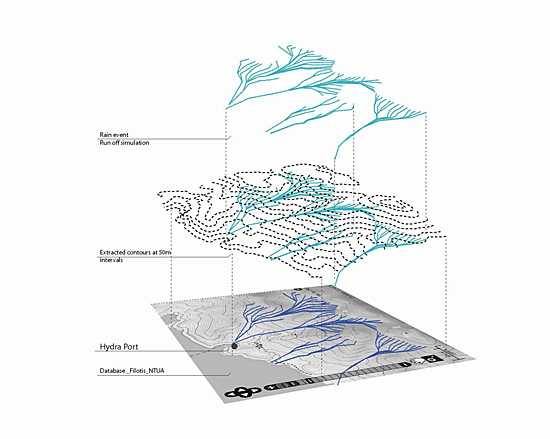
According to Karydi, 'If rain water harvesting techniques and water desalination processes have made the rule for arid territories worldwide, with a diversity of devised sustainable techniques ranging from fog-catchers to systems of swales feeding tanks, springs and wells, then Hydra rests on a rather “un-sustained chain” of water logistics where potable water gets trans-shipped daily from the coast of the Peloponnese before it gets piped into the island's water grid.'[6]
Aridity is a complex phenomenon relating not only to the potable water issue but also to land irrigation and also to hazardous erosive processes. The steep topography of the island would be the first “enabler” in this thinking, as Karydi argued because, 'the temporary network of run off channels would be the second enabler. Sustainable hydrological techniques become operational via a diversity of technologies. Run off collection, water purification for irrigation purposes are common techniques that register material ecologies in reference to both architectural and landscape prototypes.
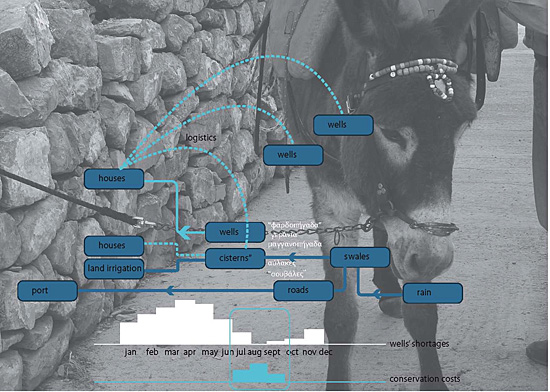
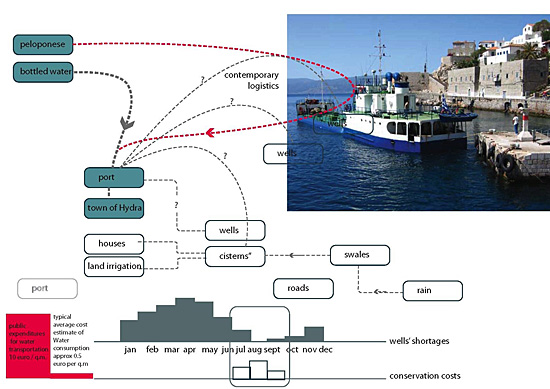
“Eleventh Plateau” takes place in a critical moment where questions about sustainable ideas and relationships between natural ecosystems and cultural practices have been reforming the field of landscape and urban design. At the outset of this change, as Karydi argued: current environmental concerns, the plotting of sustainable developments within new financial interests and a rising programmatic complexity alongside remediation processes - a constant interest towards landscape’s “treatment”- seem to fulfil the need of cultural and natural re-enactment on target sites and thus force a set of dispositions towards the representational means elaborated by practitioners in spatioenvironmental practices.[7]
According to this reading, researchers and artists are seeking to confirm the social validity of “aestheticizing” environmental issues and their cultural derivatives.
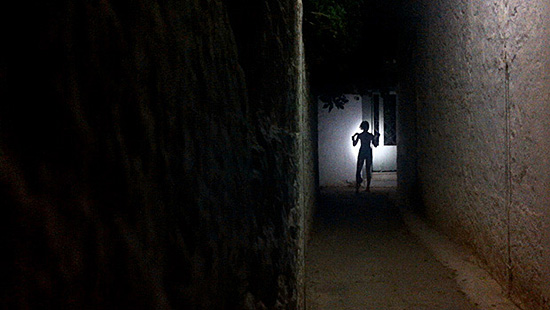
The performance ‘Fragments of the Unseen’ by the multimedia group Medea
Electronique discussed with the collaborating scientists and decided to address the “unseen” realities of the island, as discussed above, by inviting a performer to explore the environment with the use of multiple cameras and a set of binaural microphones attached to her body. By interacting with the surroundings, the performer creates new shapes like a chameleon that changes its basic characteristics according to the environment. The performer danced in a tensed location of the island where garbage are burned “illegally” with the consent of the municipality, thus the cameras filmed the burning of waste. According to the group ‘the departure point of the “unseen” is to experience a space that surrounds an entity, not through the eyes, but through the outermost points of a body. The use of multiple visual references suggests a set of possible bodily configurations that the viewer can use to identify not only the spatial configuration of the environment but also characteristics of the life form, that it represents and the relation it has to the space.’[8]
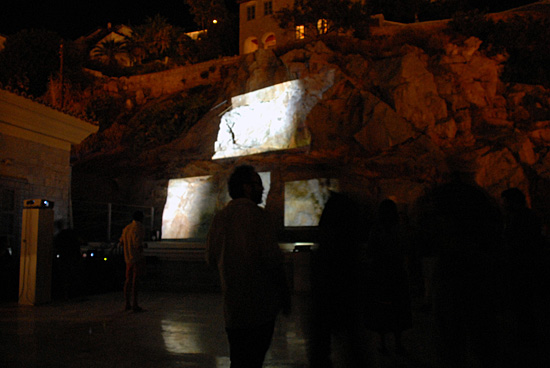
The municipality has no policy regarding the prevention, characterization, monitoring, treatment, handling, reuse and residual disposition of solid wastes and has not undertaken any policy to reduce their effect on health, the environment and aesthetics. Rather than recycling the waste the municipality burns and throws the waste at a location of the island that could be idyllic. The project disseminates knowledge to the citizens of the island concerning this significant issue by suggesting that there is a political liability concerning ecological threats and environmental destruction. The aesthetic and the ecological merge and subsequently social awareness, concerning ecological issues in a local context, is achieved.
By focusing on the ecological problem of waste management, the project raises awareness of how we perceive the environment in which we live and calls into question the certainties that we take for granted (i.e. the management of our waste).
The unseen realities of the island were also explored by ‘The Under,’ a multimedia installation by Evangelos Kaimakis who placed an underwater camera in the port of Hydra that monitors the movement of the boats and of the living organisms of the sea. The installation included the design, production and planting of an underwater monitoring system that aims to place the viewer in the environment of the sea. The experiment through the use of underwater principles attempts, according to Kaimakis, to create a visual environment that bridges everyday reality with the underwater “unknown reality.”
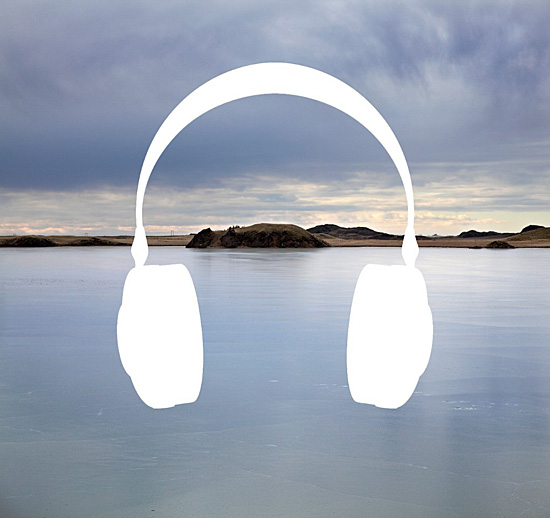
The promenade performance for one spectator ‘Trad IS(O)L and (Scapes)’ is inspired by psycho-geographical and situationist theories and by the notion of the guide as it is used in cultural events, namely, an oriented explication delivered in the form of an audio recording or through human presence.
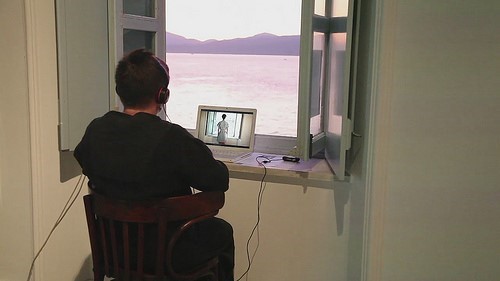
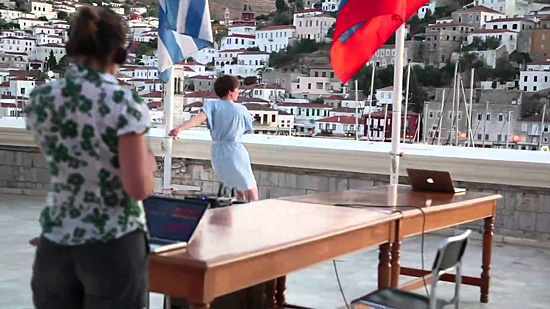
The collective Kom.post guides individual visitors to the plateaus; the performance takes the form of a promenade lecture for one visitor that allows each participant to experience intimacy in the exhibition space and at the selected sites in the landscape of Hydra. Together with the performer the participant formulates a point of view concerning the island’s milieu and “locates” her/his place so as to practice one’s own “ecology.”[9]
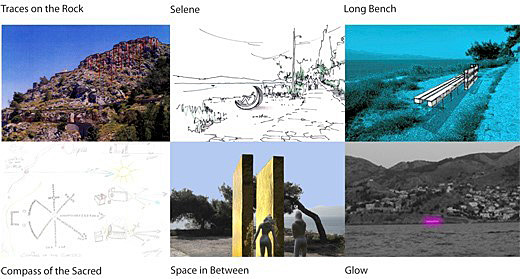
Recycled Public Art Practices
The architectural project ‘RE-Place,’ focuses on the use of recycled materials and uses these materials in order to create installations along the path of Hydra to Kamini. Thomas Amargianos, ‘Rock Traces’ examines the use of different materials and their compatibilities. The incombatibility of materials or the ways unsuitable materials are used on a surface can be captivating, since, the pieces of rope used by the islanders to tie their fishing boats constitute a “scripture” that suddenly appear as traces on the island rock.
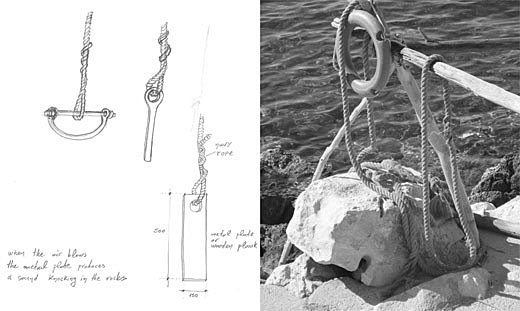
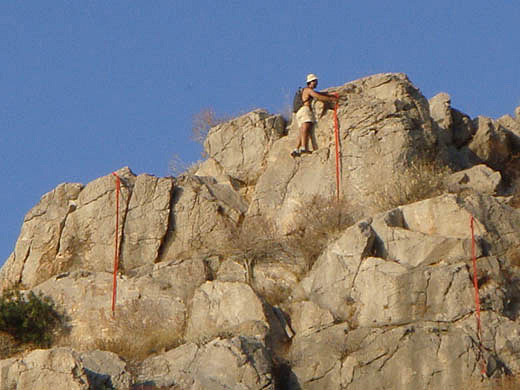
Shifts in the “visualisation” of nature participate in the harmonious landscape of Hydra, while the ephemeral graffiti is formed on the rock. The rock is used as a canvas and the pieces of rope become “traces” on the rock while the pedestrian becomes an active participant. The traces will vanish in their ephemerality. Kay Mack's ‘The Long Bench’ is made of recycled pallets and construction rods. It is intended to be a small architectural landmark located next to the path to Kamini that invites people to rest.
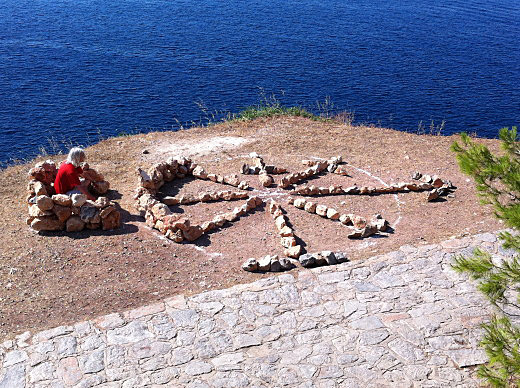
“The Compass of the Sacred” by Andrea Marcucetti stages a liturgical procession that can initiate the visitor to rediscover the sacred. According to Marcucetti ‘visitors are encouraged to walk the path with a stone in hand and to deposit it where they deem appropriate at this “location”.
This small contribution will shape the place and keep it in constant change. Despite this continuous change, The Compass of the Sacred provides a still-point of reflection, it is conceived as a religious summation that welcomes and unites in a Sumerian star symbols from diverse religions such as: Zoroastrianism, Christianity and Orthodox Catholicism, Jewish traditions, Islamic even ancient Greek religious rituals.
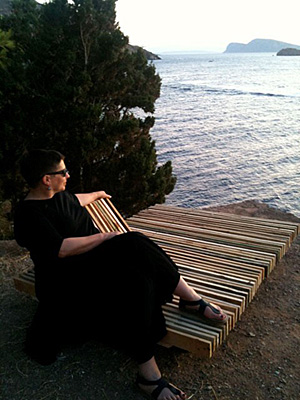
Tamiko Onozawa's ‘Engawa’ is a playful recycled furniture for people strolling by on the coastal path for stopping by, resting and enjoying the beautiful views. Engawa is a sheltered seat, made from recycled board such as paper honeycomb, cut out in a shape that allows the efficient use of board for main elements and subelements. ‘Space In-between’ by Simin Ebrahimi-Vogels and Maximilian Vogels, also employed recycled materials to create two identical objects standing at a distance to each other and forming a space for various perceptions of the sea, the sky and of the rocks.
The installation ‘Glow’ by Patricia Sendin is a smooth surface that captures the light during day and releases it after sunset. It is visible from the sea and from the path. Visitors are spectators during day and players at night when the place glows. The installation is a recycled platform that can be used for sunbathing,sitting, watching the sunset or playing. Glow is made with materials that have been found in Hydra such as pallets and plastic water bottles together with solar cells, rechargeable batteries and luminescent fabric. It is sealed with boat-making techniques to achieve a smooth finish and avoid overheating. The platform lights up automatically when the sun goes down and it glows until the batteries are empty. The layer of crushed plastic bottles above the light source helps distributing the light evenly along the surface.
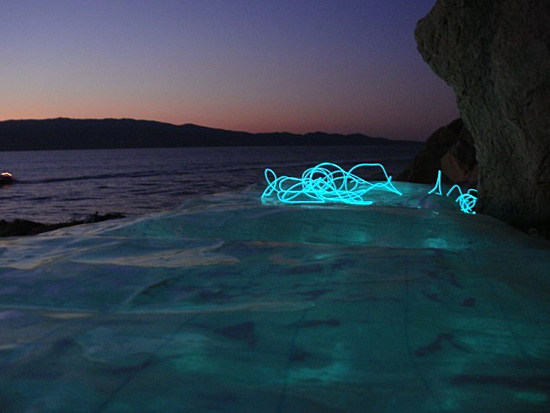
Collective Actions: Performing Light and Song
The collective performative event ‘Transmissions’ by Alexandra Stratou seeks to explore and engage the public spaces of Hydra based on their topography, density, and specific character. The town of Hydra is built amphitheatrically on a hill facing north and reaching down to the sea to form a little port. At sunset, the western section of the hill is in the shade. According to Stratou :
an intricate radial network of stepped pathways forms the street pattern of the town connecting the sea to the hilltop. This is a strictly pedestrian network populated by people, donkeys, cats, hens, and the occasional dog. Neighbourhoods in Hydra are structured along these linear paths rather than around proximity. Transmissions, is a simple act simultaneously executed by an entire linear neighbourhood, hinges on the particularities of the flowing spaces, using the street structure as its backbone.[10]
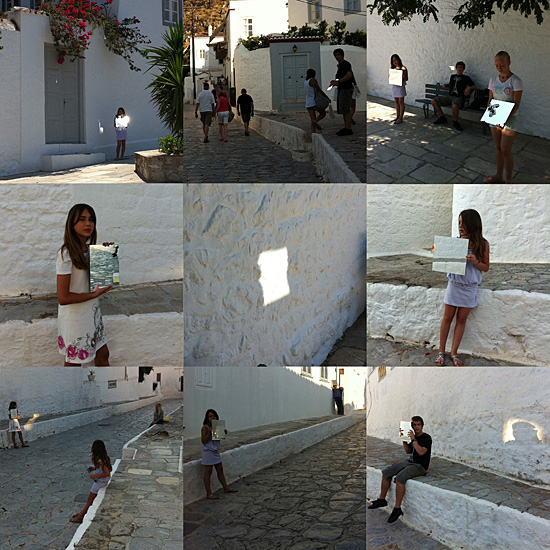
A chain of people holding mirrors gradually finds their position along a shady path of hydra. Each person manipulates the angle of their mirror and their own position so as to capture the image from the mirror of the previous person and transmit it to the next. The first person in the chain standing on the top of the hill captures the image of the sun setting.
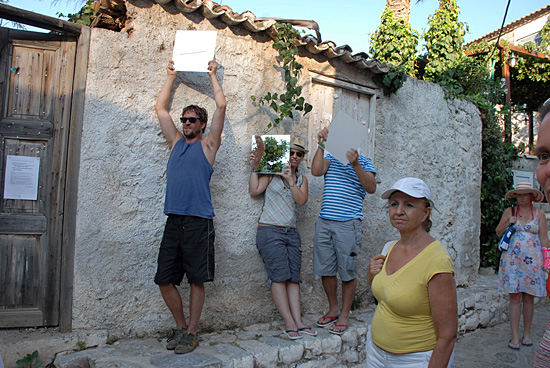
The procession assumes the density the path geometry commands, and spreads downward transferring the light. Neighbours emerge at will from their doorstep to form part of the human chain. The light-path transmits the image all the way to the sea. And thus the sea, the water, simultaneously reaches the top of the hill.
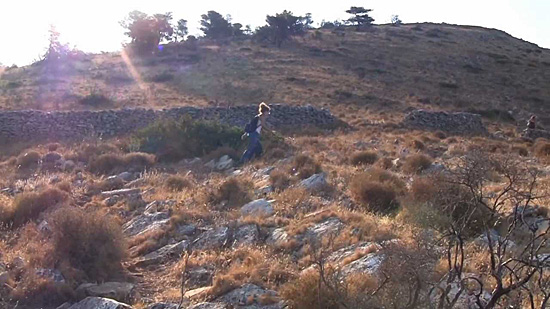
Alexandra Stratou's project focuses on the participatory context of artistic practice, similar to the Nomadic Architecture Network that contributes to the project with the site-specific performative activity ‘Il Commune-The Song.’ A new mapping of the island’s mountain is performed based on readings and songs. The song becomes a narration about the path by walking along it the group connects to the land, to the community and to the ecological and social issues of the island. The Nomadic Architecture Network researches on the ways that common resources are distributed in a particular society and attempts to reclaim these wasted resources: such as the immaterial cultural resources of collective singing. The group collected a series of poems and songs by locals, friends, theoreticians, poets and along the way to Eros Mountain these texts were inscribed, performed or recited. Short events take place during this performative path walk and the mapping of the route is invented through songs, texts and poems.
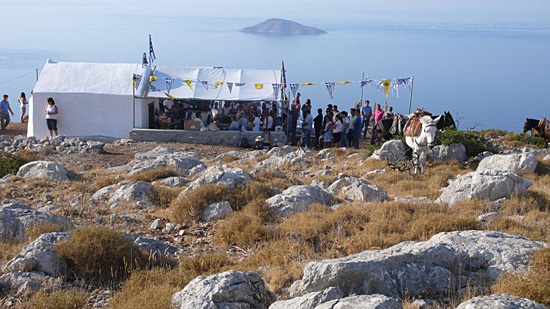
The Greek verb “nemein” (Homer) means to distribute, allocate or grant land, meat or drink. The noun “nomi” means a plot of land, a pasture, and a nomad was originally an elder, someone in charge, who was responsible for the allocation of plots. In the Mediterranean, a nomad was a shepherd who moved his animals from one pasture to another in search of food. The notion of “nomi” in its original form incorporates the concept of movement, since the nomad changes places, that is, plots of land. Among the aborigines of Australia, according to Eleni Tzirtzilaki:
[...] the main means of barter is songs and not objects. The exchange of objects is a secondary consequence of the exchange of songs. Before white people came to Australia, nobody was landless, since everybody inherited, in the form of personal property, a part of the song of their ancestor and the corresponding plot of land from which the song passed. The lyrics that someone owned were equivalent to title-deeds of his land. They could lend them to other people, or they could borrow other ones. Currently, the word “nomi” means to have power over something.[11]
Pierre Clastre makes reference to the protection of primitive societies against the formation of states. Clastre focuses on collective mechanisms, groups, herds, where leaders are deterred from consolidating their power. Nomadic architecture participated at Eleventh Plateau with the concern of establishing a new ecological ethos that can confront and protect us from contemporary precariousness and from ecological dangers.
The researchers and performers that participate in the network reflect on contemporary notions of “nomi” and of “common resources” that can be accessed by everyone such as: water, land, human resources, new cross-border collective forms, architecture, art. Il Commune: The Song proposed a new mapping based on readings and songs as a way to reclaim the redistribution of common resources. The procession reached Mount Eros, the eleventh plateau and the peak of the mountain of Hydra. By reaching the peak the group was confronted with a remarkable local feast. The community escorts their mules and donkeys to St Mamas church, to a white building of local architecture, and at the end of the liturgy, the priest blesses every animal, one by one. During this congregation humans and animals become equal, as they sense the wonder of nature.
The Eleventh Plateau: Object, Environment, Organism
Eleventh Plateau refers to the eleventh plateau from the study ‘A Thousand Plateaus’[12] by Deleuze and Guattari. It is the subject of the 11th plateau that is entitled ‘1837: Of the Refrain’. The refrain (ritournelle) is defined as (Deleuze and Guattari 1987: 356) 'any aggregate of matters of expression that draws a territory and develops into territorial motifs and landscapes' A refrain can be sonorous, musical. A bird song can be a refrain, (Deleuze and Guattari 1987: 362) 'there is no form or correct structure imposed from without or above but rather an articulation from within, as if oscillating molecules, oscillators, passed from one heterogeneous centre to another, if only for the purpose of assuring the dominance of one among them.'
Eleventh plateau creates an intra-assemblage that holds together the heterogeneous elements of the different sites/plateaus. This intra-assemblage can be seen as an alternative territory. A territory is the first thing to constitute an assemblage, and as such is fundamental to it. It is a place of passage. The territory is the critical distance between two beings of the same species.
Eleventh Plateau focuses on practices of critical intervention that promote a specific ethos relating to the definition, production, presentation and dissemination of art. The aim is to readdress in an activist sense urgent social problems such as the ecological crisis, as Kwon argued (Kwon, 2004:24):
In order to relativize art practice as one among the many form of cultural work, current manifestations of site specificity tend to treat aesthetic and art historical concerns as secondary issues. Deeming the focus on the social nature of art’s production and reception to be too exclusive, even elitist, this expanded engagement with culture favors public sites outside the traditional confines of art both in physical and intellectual terms.[13]
The artistic strategies employed at Eleventh Plateau reconsidered art’s potential to reconstitute ecological issues so as to reveal and emphasize what Nick Kaye (Kaye 2000: 270) defines as an ‘ecological logic: a logic of interdependency and transformation between object, environment and organism.’[14] The artists and architects approached the site by working over the disjunction between the “reading” of space (research) and the experience of space.
The transvaluation of ideas, metaphors, and approaches to the environment is seen as necessary to avert ecological crisis. The juxtaposition of the real with the artful and the interconnectedness of the artwork to a particular environment is of a primary concern in creating a space where aesthetic politics and eco-aesthetics could be performed. The project went beyond the theatre’s or gallery's function as the place of viewing and architecture was experienced by means of performance. As Lefevre suggested (Lefevre 1991:14), in actuality, “ideal” space, which has to do with mental (mathematico-logical) categories and “real” space, which is the space of social practice are not separate, on the contrary each of these two kinds of space involves, underpins and presupposes the other. Eleventh Plateau oscillates between these “ideal” and “real” spaces as it constructs immersive spaces of artistic and ecological practice and an intra-assemblage that holds together the “ideal” and the “real.”
Dr. Sozita Goudouna is an art theorist and curator who is currently teaching associate to Prof RoseLee Goldberg at New York University as the inaugural Andrew Mellon Curatorial Fellow at Performa New York, an arts organisation committed to the research, development, and presentation of performance by visual artists. Her research focuses on the History and Theory of Modern and Contemporary Art & Curatorial Practices and her book on the interfaces between respiration and art entitled “Mediated Breath” is forthcoming in 2016. Sozita is the visual arts curator for the forthcoming Onassis Festival in NY and the artistic director of the three-year European Union funded Research and Exhibitions Programme (2012-2015) Public Scapes: Art and Curatorial Practices in the Public Sphere and of the Kappatos Athens Art Residency.
NOTES
1 Contributing Artists and architects: Kate MccGwire, Mat Chivers, James P Graham, Augusta Ogilvy, Martin Sexton, Danae Stratou, Eleni Spiridaki, Paulina Cassimati, Vladimiros Levidis, Yiannis Christakos. Vital Space Projects, Danae Stratou, Alexandra Stratou, Fixatif Works: Eleanna Martinou, Yiorgos - Ikaros Babasakis. Nomadic Architecture Network, Eleni Tzirtzilaki. KOM.POST Collective Medea Electronique, Evangelos Kaimakis, Room For Thought: Panagiotis Malefakis, Agapi Proimou, Dimitra Stamatiou. RE: PLACE: Thomas Amargianos, Kay Mack, Andrea Marcuccetti, Tamiko Onozawa, Patricia Sendin, Maximilian Vogels, Simin Vogels, Alexandros Mykoniatis, Dimitris Makris. Scientific associates: Niki Mardas_Global Canopy, Hara Xirou_ACR+. Paris Gravouniotis_Imperial College, Io Karydi, Architectural Association researcher, Konstantinos Moraitis_National Techinical University of Athens, Bouki Babalou – Noukaki_NTUA, Petros Babasikas_UPATRAS, Athina Lazaridou_Space Syntax, Petros Lazaridis, Lina Dima, Thomas Doxiadis, Anna Laskari, Patricia Sendin. Production Associates: Cristina Stribacu, Dimitris Droulias. Eleventh Plateau is Under the Auspices of the Greek Ministry of Culture & Tourism, the British Council, MEdIES (Mediterranean Education Initiative For Enviroment & Sustainability) and Hydra's Ecological Association.
2 “Out of the Box Intermedia” is a non profit interdisciplinary arts organization actively committed to the research, development and presentation of site-responsive and intermedia projects. The organization aims to promote international exchange of practice and knowledge in the arts (visual and sound art, dance, architecture, theatre), to research on the methods used in theatre and curatorial practices and to investigate points of intersection between the arts and the public sphere by means of interventions, collective actions, educational programmes and publications. Eleventh Plateau is under the aegis of the Greek Ministry of Culture & Tourism, the British Council, MEdIES (Mediterranean Education Initiative For Environment & Sustainability) and Hydra's Ecological Association. For more information please visit: http://www.outoftheboxintermedia.org/
3 Prevelakis, P. (1971), The Head of the Medusa. Athens: Vivliopolio tis Estias.
4 Eleventh Plateau: Perceptual Ecologies and Territorial Assemblage Conference, Hydra Historical Archives Museum, July 2011, Io Karydi, unpublished conference proceedings.
5 Ibid
6 Ibid
7 Ibid
8 http://www.medeaelectronique.com/2011/05/fragments-of-the-unseen/
9 The project also included the creation of a video piece, videos from Eleventh Plateau can be accessed online at:
http://www.bstjournal.com/vol1102/sozitagoudouna/sozitagoudouna.pdf
10 Eleventh Plateau: Perceptual Ecologies and Territorial Assemblage Conference, Hydra Historical Archives Museum, July 2011, Alexandra Stratou, unpublished Conference proceedings.
11 Eleventh Plateau: Perceptual Ecologies and Territorial Assemblage Conference, Hydra Historical Archives Museum, July 2011, Eleni Tzirtzilaki, Conference proceedings.
12 Deleuze, G. & Guattari, F. (1987), A Thousand Plateaus. Minneapolis: University of Minnesota Press.
13 Kwon, M. (2004), One Place After Another: Site-specific Art and Locational Identity, Cambridge, MA: MIT Press.
14 Kaye, N. (2000) Site-Specific Art: Performance, Place and Documentation, Routledge.











